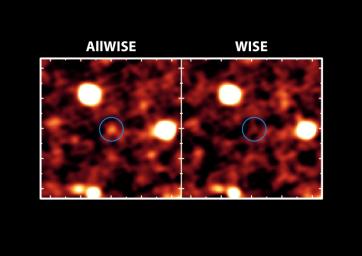The new AllWISE catalog will bring distant galaxies that were once invisible out of hiding, as illustrated in this image.
NASA's AllWISE project is providing the astronomy community with new and improved images and data taken by NASA's Wide-field Infrared Survey Explorer, or WISE, which surveyed the skies in infrared light in 2010. This is the first time that data from the entire mission so far, including two full scans of the sky, has been fully processed and made available to the public. The new catalog includes three-quarters of a billion objects, and will help with studies of nearby stars and galaxies.
The image on the right shows a portion of the sky available before the AllWISE project; the left image shows the same part of the sky in a new AllWISE image. The circle shows where a galaxy that might have gone undetected before now stands out. (The light we are seeing from this galaxy left the object 8 billion years ago, when the universe was only about 5 billion years old.) Images taken during the second sky scan were stacked up, thereby doubling the exposure time and revealing objects like this galaxy.
The image was taken at a wavelength of 4.6 microns.
NASA's Jet Propulsion Laboratory, Pasadena, Calif., manages, and operated WISE for NASA's Science Mission Directorate. The spacecraft was put into hibernation mode after it scanned the entire sky twice, completing its main objectives. Edward Wright is the principal investigator and is at UCLA. The mission was selected competitively under NASA's Explorers Program managed by the agency's Goddard Space Flight Center in Greenbelt, Md. The science instrument was built by the Space Dynamics Laboratory in Logan, Utah. The spacecraft was built by Ball Aerospace & Technologies Corp. in Boulder, Colo. Science operations and data processing take place at the Infrared Processing and Analysis Center at the California Institute of Technology in Pasadena. Caltech manages JPL for NASA.
More information is online at http://www.nasa.gov/wise and http://wise.astro.ucla.edu and http://jpl.nasa.gov/wise.

 Planetary Data System
Planetary Data System












